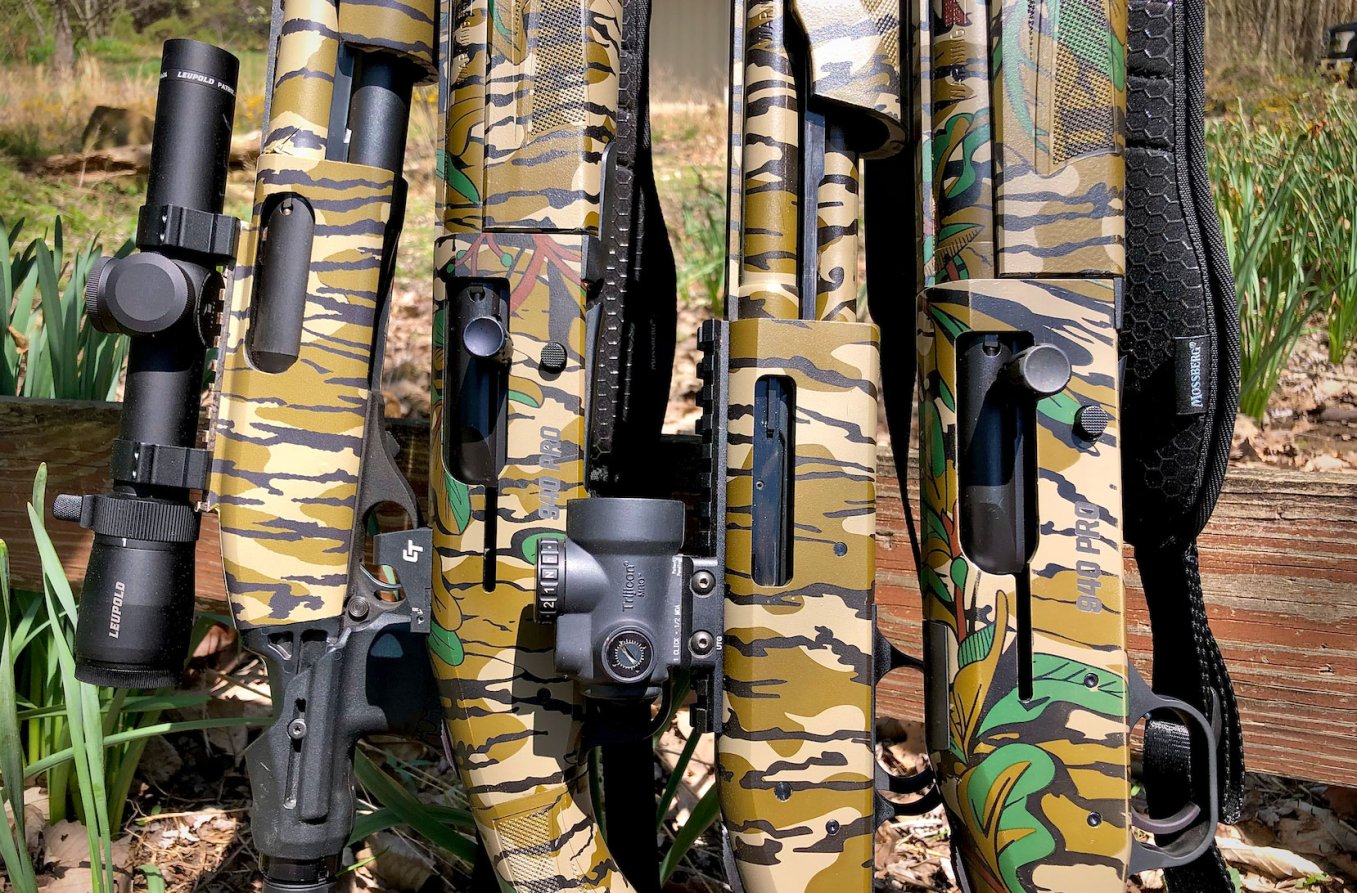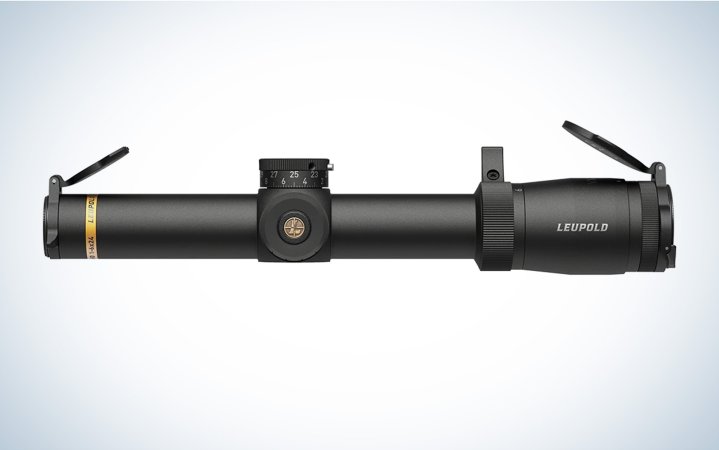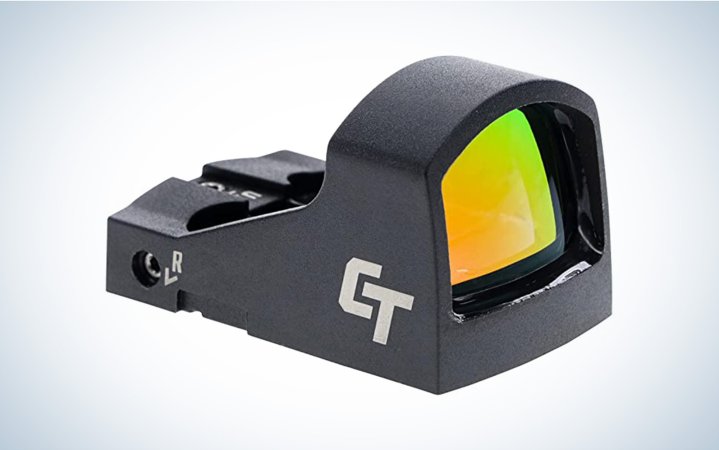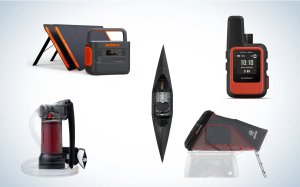We may earn revenue from the products available on this page and participate in affiliate programs. Learn More ›
It wasn’t too long ago that a “turkey gun” meant any shotgun you decided to take turkey hunting. But in the modern era of specialized hunting equipment, the best turkey guns sport short barrels, TSS chokes, and optics. But do you really need a red dot sight or scope on your turkey gun? That all depends on the type of hunting you like to do, and the expectations you have for your turkey hunting rig.
If you hunt in the woods and are dedicated to killing gobblers at 30 yards or in, I’d argue the best aiming mechanism you could have on your shotgun is a simple, plain bead. But if you plan on stretching your turkey gun to 40 yards and beyond, adding a red dot sight or scope will make you a more precise shooter. Over the years I’ve killed turkeys through scopes, red dot sights, while looking down irons, and floating beads over a gobbler’s wattles. Here’s an honest look at the pros and cons for each.
Scopes for Turkey Hunting
Pros
- Magnification
- Versatility
- Lighted reticles
- Precise aiming at mid and long ranges
- Many LPVO options
- Quick sight in
Cons
- Adds weight
- Lose field of view with magnification
- Pricey

Throwing a scope on a shotgun for turkey hunting, where shots shouldn’t range much beyond 60 yards, might seem like overkill. But don’t knock it until you try it. There’s a reason that low power variable optics (LPVOs), like the Leupold VX-6HD, have become hyper-popular in the world of AR-style rifles: They allow for fast target acquisition at close range and for precise aiming at longer ranges. These compact optics, which start at 1x magnification and then range up to 4x, 6x, 8x and 10x, will also make excellent hunting scopes in the turkey woods.
I recently mounted a Leupold Patrol 6HD 1-6X24 scope on my Remington 870 turkey hunting gun. It was a breeze to sight in and I loved the precise aiming the lighted reticle offered. However, I was initially concerned that the scope would slow me down if I had to make a quick shot at close range. But on the second day of the Indiana turkey season, I was surprised to see a longbeard sneaking my way through heavy brush. He was only about 25 yards away. I threw the gun up as the turkey putted and started ducking for cover. Without an instant of hesitation, I found his red head in the scope and fired. The gobbler was dead where he stood. On 1x power, and with an illuminated reticle, target acquisition is extremely quick with a good LPVO. There is no shifting back and forth to find the proper eye relief or adjusting your head position. On 1x, I found my Leupold Patrol scope had about 5 inches of eye relief, which is more than generous. Simply bring the gun up, look through the scope, and shoot. With a little practice, you’ll do this quickly and with both eyes open.

Even at close ranges, a scope is useful because it forces you to keep your head down on the gun. Turkeys are most-often missed when the shooter brings their head off the gunstock and looks over the barrel—instead of down it—at that giant strutter coming in (sadly, I know a little bit about this from personal experience). But to see through your scope, you must get your head down with your cheek welded on the stock, and this is the first step toward a flopping turkey.
But longer shots, from 40 to 60 yards, are where a scope really shines on a turkey gun. Even just cranking the power up to 2x or 3x gives you a much clearer picture of the gobbler’s head and neck. I noticed this immediately while patterning turkey guns at 60 yards; it was much easier to shoot consistently at this range with a scope. Lastly, a high-quality scope will give you a clear and bright sight picture even in low light conditions, this of course makes shooting easier, but also more fun.
A note on shooting turkeys at “long range,”: Each hunter must decide their own maximum effective range. And just because you can kill a longbeard at 60 or 70 yards, doesn’t necessarily mean that you should. A recent field test we did on TSS turkey loads at long range showed that no one should be shooting at turkeys beyond 70 yards. In my opinion, turkey hunting at its finest is a close-range game. With all of that said, there is no doubt that modern turkey hunting rigs and ammo can effectively kill gobblers at 60 yards when in the right hands. And when shooting at that range, a scope will help you be more precise.
Red Dot Sights for Turkey Hunting
Pros
- Wide variety of low-profile options
- Intuitive to use and shoot
- Same point of impact regardless poor gun mount or head position
- Ability use bead for a backup
- Variety of mounting options
Cons
- Must consider battery life
- Must consider dot brightness
- Potential for tinted sight picture

Just as LPVOs have taken off with AR shooters, red dot sights (or more specifically, reflex sights) are red hot with pistol shooters. There are dozens of low-profile red dot sights on the market these days and many of them will work wonderfully on a turkey gun.
In general, red dots are ideal for turkey hunting because they assist with fast target acquisition, they help with precise aiming at close and mid ranges, and they are very intuitive to use. Simply put the dot on the gobbler’s wattles and press the trigger. Just like with scopes, they force the shooter to get down on the gun and look through the sight. For these reasons, red dots are ideal for new turkey hunters.
READ NEXT: Best Red Dot Sights
But they’re also useful for old veteran turkey hunters, too. Red dot sights allow you to shoot with the same point of impact no matter how the gun might be canted or your head might be angled. So, if a tom approaches from your offside and you can’t get a perfect gun mount (or even if you have to shoot weak-handed with your non-dominant eye) the concept is still the same: put the red dot on the gobbler’s neck and squeeze. Red dots have another advantage over open sights because they don’t obscure the lower part of your target (more on this later).
There are two main types of red dots that are of interest to turkey hunters: tube sights and exposed reflex sights.

Tube sights (see above) ride a little higher above the receiver and might require adding comb height to your shotgun. On the upside, they are typically easier for adjusting brightness settings and swapping out batteries. Overall, they’re also a little more durable because everything is enclosed inside a tube. I’ve hunted a lot with both the Trijicon MRO and the Leupold Freedom RDS and both have performed perfectly.
Exposed reflex sights (see below) have a much smaller profile on your shotgun’s receiver. This means that you likely won’t have to mess with comb height to get a proper cheek weld. Because the sights are typically designed for mounting on personal protection pistols, many of them are motion activated or set to “always on” and have auto brightness settings for the dot. I was originally skeptical about auto-brightness for a hunting scenario. But then I hunted for a week with the very simple Crimson Trace CTS 1550 on a Mossberg 940 JM Turkey Pro, which has a cut-out in the receiver to accommodate a compact red dot sight. After hunting with the sight and testing the brightness of the dot as I changed locations throughout the first morning, it was obvious that dot brightness was not going to be an issue. With the gun mounted, aiming from shade to sunlight, I could see the dot change brightness automatically. The only real downside of the Crimson Trace sight, and many other reflex sights like it, is that it has a slightly tinted lens. This makes the dot easier to see, but could be a bit of a hinderance if you’re trying to spot a turkeys head through thick cover in low light.

But what about battery life you might ask? What happens when you finally call that gobbler into range only to find out that your fancy sight has a dead battery? To this I would reply: Fear not boomer, modern red dots have incredible battery life.
The basic Crimson Trace sight has a battery life of 20,000 hours (or two-plus years according to the company). Simply swap a new battery in every other season and you’ll never have to worry. The Trijicon sight has a battery life of five years. Beyond that, the low-profile reflex sights allow you to still look through the sight, see down the barrel, and use your shotgun’s bead. So even if, somehow, your sight dies on you in the moment of truth, you’d still be able to aim and shoot using your bead as a backup. For this reason, it is wise to practice shooting your gun with the sight mounted but switched off. Because chances are, the point-of-impact will change even if you put the bead on the gobbler’s head. This is especially true for shotguns that shoot a high pattern.
How to Sight In a Red Dot or Scope on Your Turkey Gun
If you shoot a popular modern turkey shotgun, there’s a good chance the receiver will be drilled and tapped for mounting an optic. Simply find a rail that is compatible with your gun and optic, and you’re off to the range. If you go with one of the low-profile reflex sights designed for pistols, a simple adapter plate will allow you to mount it to a rail.
From there, you’ve got to sight the optic in. Here’s how I like to do it…
1) Set up a large paper target at close range (10 to 15 yards).
2) Put the gun in a rest and point your bead just below the center of the target.
3) Move your red dot or reticle so that it is at the center of the target.
4) Shoot a target load (they are cheaper and easier on your shoulder). Your pattern will be fist-sized tight.
5) With the gun still in the rest, put the red dot back on target. Now, while looking through the sight, move the dot (using the sight’s elevation and windage adjustments) to the center of your pattern. Be careful not to move the gun while doing this. It helps to have a partner move the sight while you look through it.
6) Shoot another target load. You should be dead on now. If not, make micro adjustments.
7) Now you can get to actually patterning your gun with hunting loads. Here’s how to pattern a turkey gun.
Beads and Open Sights for Turkey Hunting

Pros
- No maintenance required
- Fastest to get on target for snap shooting
Cons
- Imprecise aiming
- Easy to pull your head off the gun
- Potentially more difficult to sight in
- Obscures the target
I’m lumping plain beads and open sights (or irons) together because they fit the “not optics” category. Many turkey-specific shotguns come with iron sights, but more accurately, these are typically made of plastic. In my experience, the sights that come on turkey guns are usually of low quality. The advantage to using irons is that you can adjust them and actually sight in your gun. Changing point of impact in relation to your point of aim with a bead is much more of a chore. Now, don’t get me wrong, skilled shooters can use iron sights for incredible accuracy at much longer ranges than anyone is shooting turkeys. But shooting precisely with irons is a true skill that needs to be practiced. I do not know anyone who spends a lot of time target shooting with their turkey gun.
So, if I’m going to hunt turkeys without an optic on my gun, I want to have a bead—and a simple one at that. Most turkey hunters are also upland bird hunters or duck hunters. We’re used to looking down a shotgun barrel, focusing on our target, and shooting. This method works just fine for most turkey shooting scenarios, too. In fact, sometimes it’s superior. I’ve killed gobblers that have been running away from me. I’ve also killed turkeys out of the air (making a second shot after my hunting partner shot first). In these instances, I was glad I had a simple bead on my gun and I was able to shoot instinctually just as I would shoot a giant flushing pheasant. If you have to make a snap shot at close range, a small bead is best because you have the option of using it as a reference point or ignoring it completely, focusing on the bird’s head, and pulling the trigger.
The downside of both iron sights and beads is that they obscure the lower half of the target. That makes them much less precise for aiming at farther ranges. At 60 yards, that fat green bead at the end of your barrel will cover up most of a gobbler’s head and neck. Also, I think that hunters have a tendency shoot over turkeys when using open sights. They’re so focused on that giant gobbler strutting into range that they don’t get down on the gun. This leads to a miss at close range or long range.
If you’re like me and spend a lot of time turkey hunting each spring, working hard to bring gobblers into range, you want to make each shot count. It’s worth it to add an optic to your turkey gun, whether you’re shooting at 60 or at 20 yards.



